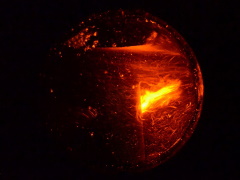Features
Plasma quest
Date: 2020-09-29 14:27:25.0
Author: Jon Evans

The plasma chamber in the experimental
reactor at the Leibniz Institute for Plasma
Science and Technology.
Photo: B. Honnorat, V. Brüser and J.F. Kolb.
Researchers are looking further and further afield in their quest for novel pre-treatment methods that are cheaper and more effective than the combination of heat and corrosive chemicals currently used for breaking down biomass prior to conversion into biofuels and biogas.
This quest began with novel liquid solvents such ionic liquids, which are salts that are liquid at room temperature (see An equal relationship), and deep eutectic solvents (DESs), which are similar to ionic liquids, being based on quaternary ammonium salts, but are cheaper and easier to produce. As an added advantage, it now turns out they can be greener as well.
In a paper in ACS Sustainable Chemistry & Engineering, a team of researchers from the US and Korea report creating a DES by mixing together two chemicals – choline chloride, as the quaternary ammonium salt, and p-hydroxybenzoic acid, which can be derived from lignin. The resulting DES could break down the lignin in poplar wood with an efficiency of 69% to release the cellulose, which could then be converted into glucose by enzymes with a yield of 90%.
Others are moving on from liquid solvents to reactive gases. A team of researchers at the US National Renewable Energy Laboratory (NREL), led by Zia Abdullah, is investigating the potential of treating biomass with ozone (O3), which is a powerful oxidant. Such treatment, known as ozonolysis, is already widely used for bleaching paper, but Abdullah and his colleagues wondered whether ozone's powerful oxidation properties could also allow it to be used for pre-treatment.
When combined with mechanical refining, they found that not only did ozone help to break down the lignin in corn stover to release the cellulose, but also increased the yield of glucose from this cellulose to over 90%. This increased yield more than offset the additional cost of the ozonolysis.
Keeping with the oxidation theme, Bruno Honnorat and his colleagues at the Leibniz Institute for Plasma Science and Technology in Germany have explored the potential of using a plasma to break down plant biomass. A plasma is a cloud of highly charged ions, and Honnorat and his colleagues produced it by firing short pulses of microwaves at a solution of sodium carboxymethyl cellulose, acting as a model biomass solution, flowing through a reactor.
As they report in a paper in AIP Advances, microwave pulses with a duration of 12.5 milliseconds and a power of 1950 watts were able to strip electrons from the molecules in the solution and produce an expanding plasma bubble. This plasma then not only broke down the sodium carboxymethyl cellulose directly, but also generated oxidizing agents such as hydroxyl radicals that contributed to breaking it down. This was reflected in a detectable reduction in the viscosity of the solution, as the long cellulose polymer was broken down into smaller molecules.
Honnorat was particularly pleased that he and his colleagues were able to generate the plasma in a flowing solution, which suggests this plasma treatment could form the basis for a continuous process. "The most surprising thing was to be able to obtain plasma discharge conditions in a moving liquid," he said. "The presence of a flow considerably complicates the situation compared to all the other experimental setups studied in the literature."
Following this success, Honnorat and his colleagues are now planning to study this plasma pre-treatment process in more detail, to determine exactly what oxidizing agents are generated by the plasma. Meanwhile, in partnership with an industrial agriculture partner, they intend to test it in a commercial biogas plant, where the plasma will break down the biomass before it is converted into biogas by anaerobic bacteria.
The views represented here are solely those of the author and do not necessarily represent those of John Wiley and Sons, Ltd. or of the SCI.
Displaying 2 keywords used to tag this article:
- DG6582 Mens Moncler Down Jackets Gr
- Jules Audemars-Australia Best Quali
